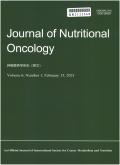Validity of the Patient-Generated Subjective Global Assessment (PG-SGA) in Colorectal Cancer Patients in China
引用次数: 1
Abstract
Abstract: Objective The patient-generated subjective global assessment (PG-SGA) is a nutritional assessment tool specially designed for cancer patients. This study tested the validity of the PG-SGA for the nutritional assessment of colorectal cancer (CRC) patients in China. Methods A total of 8,093 Chinese patients with any stage CRC were enrolled in this cross-sectional, observational study. Within the first 48 hours of admission, patients were evaluated using the PG-SGA, nutritional risk screening 2002 (NRS 2002), Karnofsky Performance Status (KPS), and some anthropometric parameters, including the triceps skinfold thickness (TSF), mid-arm circumference (MAC), mid-arm muscle circumference (MAMC), hand grip strength (HGS), maximum left calf circumference (MLCC), and maximum right calf circumference (MRCC), among others. Spearman’s correlation test was performed to analyze item-total score correlations and correlations between the total PG-SGA score and other parameters or performance scores, further testing convergent validity. The discriminative ability of the PG-SGA was measured by comparing different characteristics between several nutritional groups. A principal component analysis was performed with selected parameters to evaluate the construct validity. Results The average total PG-SGA score of all patients was 5.69 ± 4.46, and they had a median age of 59 years (interquartile range (IQR), 51-67 years) and an average body mass index (BMI) of 22.57 ± 3.29 kg/m2. The item-total correlations of the total PG-SGA score between the global PG-SGA rating (Spearman, r = 0.94) and PG-SGA score (patient-generated) (Spearman, r = 0. 97) were strong. Significant correlations were also found between the total PG-SGA score and other nutritional screening tools, including the BMI (Spearman, r = -0.26), KPS (Spearman, r = -0.36), and NRS 2002 (Spearman, r = -0.47). Well-nourished (41.2%), mildly or moderately malnourished (35.3%) and severely malnourished (23.5%) groups defined according to the PG-SGA had significantly different characteristics. Patients with a worse nutritional status tended to have a decreased BMI (well-nourished, 23.32 kg/m2 vs. mildly or moderately malnourished, 22.52 kg/m2 vs. severely malnourished, 21.35 kg/m2; P < 0.001), hemoglobin, body fat mass, muscle mass, protein mass, TSF, MAC, HGS, MAMC, and MLCC, and a dramatically increased C-reactive protein level. The Kaiser-Meyer-Olkin measure was > 0.7, and the P value of Bartlett’s test of sphericity was < 0.001. One component was extracted by the principal component analysis, and the analysis showed that the total PG-SGA score explained the total variances of 97.3%. Conclusion The PG-SGA is a valid tool for evaluating the nutritional status for Chinese CRC patients.中国结直肠癌患者主观整体评估(PG-SGA)的有效性
摘要:目的患者生成的主观全局评估(PG-SGA)是专门为癌症患者设计的营养评估工具。本研究验证了PG-SGA用于中国癌症(CRC)患者营养评估的有效性。方法对8093例不同阶段CRC患者进行横断面观察研究。在入院后的前48小时内,使用PG-SGA、2002年营养风险筛查(NRS 2002)、卡诺夫斯基表现状态(KPS)和一些人体测量参数对患者进行评估,包括三头肌皮褶厚度(TSF)、上臂围(MAC)、上臂肌围(MAMC)、握力(HGS)、最大左小腿围(MLCC),以及最大右小腿周长(MRCC)等。采用Spearman相关性检验分析项目总分的相关性以及PG-SGA总分与其他参数或表现分数的相关性,进一步检验收敛有效性。通过比较几种营养组之间的不同特征来测量PG-SGA的辨别能力。用选定的参数进行主成分分析,以评估结构的有效性。结果所有患者的平均PG-SGA总分为5.69±4.46,中位年龄为59岁(四分位间距(IQR),51-67岁),平均体重指数(BMI)为22.57±3.29kg/m2。总体PG-SGA评分(Spearman,r=0.94)和PG-SGA得分(患者生成)(Spearmman,r=0。97)都很强。PG-SGA总分与其他营养筛查工具之间也存在显著相关性,包括BMI(Spearman,r=-0.26)、KPS(Spearmman,r=-0.36)和NRS 2002(Spearmon,r=-0.47)。根据PG-SGA定义的营养良好(41.2%)、轻度或中度营养不良(35.3%)和严重营养不良(23.5%)组具有显著不同的特征。营养状况较差的患者往往BMI(营养良好,23.32 kg/m2 vs.轻度或中度营养不良,22.52 kg/m2 vs严重营养不良,21.35 kg/m2;P<0.001)、血红蛋白、体脂量、肌肉量、蛋白质量、TSF、MAC、HGS、MAMC和MLCC降低,C反应蛋白水平显著升高。Kaiser-Meyer-Olkin测量值>0.7,Bartlett球度检验的P值<0.001。通过主成分分析提取了一个成分,分析表明PG-SGA总分对总方差的解释率为97.3%。结论PG-SGA是评估中国CRC患者营养状况的有效工具。
本文章由计算机程序翻译,如有差异,请以英文原文为准。
求助全文
约1分钟内获得全文
求助全文

 求助内容:
求助内容: 应助结果提醒方式:
应助结果提醒方式:


